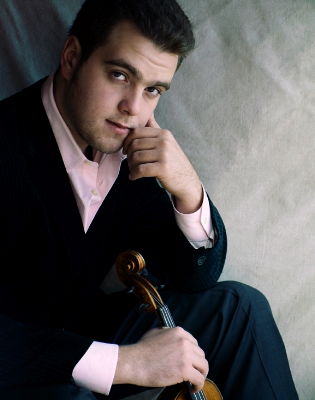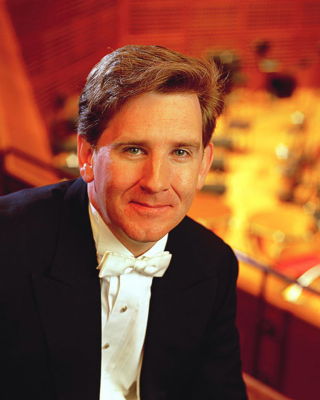|

Incisive Performance
LAWRENCE BUDMEN reports from
the New World Symphony's new season
Celebrating its 22nd year, the New World Symphony officially opened its season with a French-Russian program under the baton of artistic director Michael Tilson Thomas on 10 October 2009 at the Lincoln Theater in Miami Beach, Florida, USA. As America's Orchestral Academy, the New World has been a training ground for nearly a generation of orchestral musicians. New World alumni populate orchestras throughout North and South America, Europe and Asia (including many first chair positions). Each season thirty musicians join the eighty-three member ensemble for rotating terms. Participating in a full season of orchestral performances, chamber music programs, coaching sessions and master classes, the New World fellows work with many of the world's leading conductors, soloists and teachers.
The orchestra was in top form for Berlioz's Roman Carnival Overture, the evening's curtain raiser. The richly burnished dark sound of the lower strings traced the plaintive English horn melody (evocatively rendered) in the lyrically expansive introduction. Tilson Thomas' perfectly gauged sense of pace and flow kept the ensuing allegro from being frenzied. French charm was never sacrificed to superficial excitement. Berlioz's music sang and beguiled, invigoratingly articulated by the gifted young musicians.
New World conducting fellow Edward Abrams (who has studied with Otto Werner Mueller, David Zinman and Tilson Thomas) led an incisive performance of Mussorgsky's Night on Bald Mountain that roared with orchestral fury, just in time for Halloween. Abrams' control of orchestral balance and textures was solid and impressive. He allowed the music room to breathe, suffusing the Rimsky-Korsakov finale with poetic sensibility. Abrams is a highly promising conducting talent.

Mikhail Simonyan. Photo © Lisa Marie Mazzucco
|
Alexander Glazunov's rhapsodically lyrical Violin Concerto in A minor, Op 82, is too infrequently played. Infused with wonderfully inspired melodic invention, the concerto is a stellar virtuoso vehicle, merciless in its technical demands and musically transparent as to reveal a soloist's most minor failing. This writer recalls a memorable 1970s performance by the superb Romanian violinist Silvia Marcovici (who recorded the work with Leopold Stokowski conducting). At this New World Symphony concert, the demanding concerto was played by the young Russian violinist Mikhail Simonyan. At age fifteen, Simonyan gave a dazzling performance of Khachaturian's Violin Concerto on tour with the American-Russian Young Artists Orchestra under the formidable Leon Botstein. Less than a decade ago this formidably gifted prodigy's playing recalled such past masters as Heifetz and Oistrakh. Now in his early twenties and a student at New York's Juilliard School, Simonyan proved a disappointment. He struggled manfully with the Glazunov concerto. Too often his playing lacked dynamic variety and sheer bravura. (Simonyan never really essayed a pianissimo.) Despite a brilliantly executed cadenza, Simonyan seemed to lack the charisma and virtuosic flair that makes Glazunov's showpiece come alive. Tilson Thomas provided an x-ray delineation of the colorful orchestral writing, drawing exciting playing and vivid sonorities from all sections of the orchestra.
With Tilson Thomas' high energy leadership on the podium, Ravel's Daphnis and Chloe Suite No 2 received a near ideal performance. Although the Lincoln Theater's over-bright acoustics are not conducive to large scale orchestral scores, the conductor managed to evoke cycloramic splashes of instrumental color. The lustrous magic of the strings in the opening Sunrise put an exclamation point on Ravel's orchestral wizardry while the winds' gossamer textures in the Pantomime led to a full throttle rendition of the General Dance. Despite the high decibel levels, Tilson Thomas fused finesse with fire in a capital reading of Ravel's greatest orchestral score. With the crème de la crème of the nation's top music conservatory graduates, the New World Symphony is an incredible artistic resource. The ensemble's performance of Daphnis and Chloe was the work of a major league orchestra.

Alasdair Neale
|
Two pre-season concerts showcased the New World in diverse scores from the highways and byways of orchestral literature. Principal guest conductor Alasdair Neale led an American-British program on 26 September. John Adams' quirky, ironic, post-modern The Chairman Dances: Foxtrot for Orchestra was originally intended for the iconic American composer's opera Nixon in China. At once sensuous and sarcastic, Adams' gem of a vignette was played with clean, vigorous articulation by the orchestra.
The highlight of the concert was Finding Rothko, a recent score by American composer Adam Schoenberg (born 1980). Inspired by the visionary abstract paintings of Mark Rothko (1903-1970), Schoenberg has created a musical portrait of four of Rothko's restrictive formal outlines of color based paintings. A principal Rothko motif connects the four sections (Orange, Yellow, Red, Wine) of this single movement work. In the final part Wine, Schoenberg expands the Rothko thematic thread in a lyrically elongated form that glows with orchestral luster. Rothko's paintings were projected on a screen behind the orchestra as the musical portraits took voice. Schoenberg is a master instrumental tone painter. The sensuous, multi colored instrumental writing marks Schoenberg's delightful essay as impressionism for the 21st century. Obviously an enthusiastic advocate for this appealing score, Neale drew gleaming tonal shades and hues from the New World players. Schoenberg was present to acknowledge the audience's enthusiastic response.
From the dawn of the twentieth century came Elgar's concert overture In The South (Alassio), Op 50 (1904), a glittering tone poem cast in contrasting moods of darkness and vibrant Italian sunlight. A soaring viola solo highlighted an effusive performance, Neale finding heart and depth beneath the surface Mediterranean brio. The orchestra's finely polished sheen perfectly captured Elgar's distinctive sound palette.
Britten's ageless Young Person's Guide to the Orchestra was a triumphant conclusion with Neale coaxing a brilliant, joyous cascade of instrumental timbres from every section of the ensemble.
Violinist and chamber orchestra specialist Scott Yoo led a string oriented concert on 20 September. Opening with Autumn Rhapsody, a partially minimalist score by Pierre Jalbert (born 1967), Yoo directed a brightly exuberant reading of Mendelssohn's enchanting Sinfonia No 8 in D major and a silky Adagietto from Mahler's Symphony No 5 in C sharp minor.
The concert's pièce de résistance was the Petite symphonie concertante for harpsichord, piano, harp and orchestra by Frank Martin (1890-1974). Once nearly a staple of the chamber orchestral repertoire, this score has been rarely played in recent seasons. Indeed Martin's output has largely fallen off the concert radar in North America. That is doubly unfortunate because the Swiss composer was a distinctively original voice in twentieth century music.
Although he absorbed atonality into his compositional oeuvre, Martin did not blindly follow Schoenberg's theories. The Petite symphonie concertante is a continuous three movement theme and variations. While the principal theme is indeed a twelve tone fragment, the majority of the score is lyrical, vigorous and replete with varied instrumental contrasts. The central Adagio, the soulful heart of the score, may be the only work in the Western musical canon with an extended duet for harpsichord and harp. Hearing this enticing score was a real treat, especially as brilliantly executed by Yoo and a virtuosic New World string section with compelling solo turns.
Copyright © 18 October 2009
Lawrence Budmen,
Miami Beach, USA

On 24 and 25 October 2009, the New World Symphony plays an all Beethoven program featuring highlights from Fidelio and the Ninth Symphony conducted by Michael Tilson Thomas at the Adrienne Arsht Center in Miami, Florida, USA. Soloists are soprano Christine Brewer, mezzo-soprano Kendall Gladen, tenor Anthony Dean Griffey and bass Luca Pisaroni with the Master Chorale of South Florida and University of Miami Frost Chorale, Joshua Habermann, director. The New World Symphony returns to the Lincoln Theater in Miami Beach on 1 November for an all-Mozart chamber musicale featuring A Musical Joke, Flute Quartet No 3 and Symphony No 38 (Prague) with guest violinist Todd Phillips. Jeffrey Milarsky conducts New York State of Mind on 7 November featuring scores by Lang, Ziporyn and Gordon with David Cossin, percussion, Felix Fan, cello and Andrew Russo, piano/synthesizer. On 14 and 15 November, Alasdair Neale directs Prokofiev's American Overture, Tchaikovsky's Pathetique Symphony and Osvaldo Golijov's Dreams and Prayers of Isaac the Blind with klezmer clarinetist David Krakauer. Osmo Vanska conducts Stravinsky's Song of the Nightingale, Brahms' Fourth Symphony and Haydn's Cello Concerto in D with Alban Gerhardt on 4 and 5 December. On 19 and 20 December 2009, Mark Wigglesworth leads Milhaud's Creation of the World, Ravel's Mother Goose Suite, Richard Strauss' Suite from Der Rosenkavalier and Berg's Seven Early Songs with soprano Measha Brueggergosman. For information, see www.nws.edu |
|

